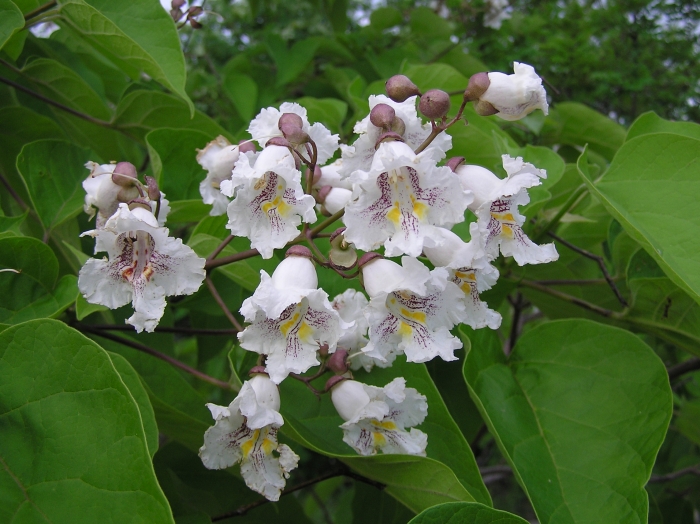Southern Catalpa
(Catalpa bignonioides)
Southern Catalpa (Catalpa bignonioides)
/
/

Le.Loup.Gris
CC BY-SA 3.0
Image By:
Le.Loup.Gris
Recorded By:
Copyright:
CC BY-SA 3.0
Copyright Notice:
Photo by: Le.Loup.Gris | License Type: CC BY-SA 3.0 | License URL: https://creativecommons.org/licenses/by-sa/3.0 | Uploader: Le.Loup.Gris | Publisher: Wikimedia Commons | Title: Catalpa_bignonioides_inflorescence.jpg |





















































Estimated Native Range
Summary
Catalpa bignonioides, commonly known as Southern Catalpa, is a deciduous tree native to river floodplains and warm temperate regions of the Southeastern USA. It typically grows to 15–18 meters (50–60 ft) tall, with a trunk up to 1 meter (3 ft 3 in) in diameter. The bark is brown to gray, maturing into hard plates or ridges. The tree’s structure is characterized by a short, thick trunk and long, straggling branches that form a broad and irregular crown. The large, bright green, heart-shaped leaves emerge late in the season and are notable for secreting nectar through glands at the base of the primary veins—a rare trait among leaves. Southern Catalpa’s flowers are showy, 2.5–4 cm across, trumpet-shaped, and white with yellow spots inside, blooming in panicles of 20–40. Flowering occurs in June or early July in the northern states of the USA, creating a dense coverage that nearly conceals the foliage. The overall effect is of a pure white canopy, although each flower is intricately spotted with purple and gold.
Southern Catalpa is celebrated for its ornamental value, boasting some of the most spectacular flowers among American native trees. It is a popular choice for parks and gardens in temperate regions worldwide. The tree’s late bloom time provides extended interest after many other trees have finished flowering. In cultivation, it thrives in moist soils and full sun to part shade. It is relatively easy to propagate from seeds, which germinate promptly, or from cuttings. Southern Catalpa is generally disease-resistant and has few insect pests. However, it requires low to medium water and well-drained soils. Gardeners should be cautious of its potential invasiveness outside its native range and check local guidelines before planting.CC BY-SA 4.0
Southern Catalpa is celebrated for its ornamental value, boasting some of the most spectacular flowers among American native trees. It is a popular choice for parks and gardens in temperate regions worldwide. The tree’s late bloom time provides extended interest after many other trees have finished flowering. In cultivation, it thrives in moist soils and full sun to part shade. It is relatively easy to propagate from seeds, which germinate promptly, or from cuttings. Southern Catalpa is generally disease-resistant and has few insect pests. However, it requires low to medium water and well-drained soils. Gardeners should be cautious of its potential invasiveness outside its native range and check local guidelines before planting.CC BY-SA 4.0
Plant Description
- Plant Type: Tree
- Height: 30-40 feet
- Width: 20-40 feet
- Growth Rate: Rapid
- Flower Color: White
- Flowering Season: Spring
- Leaf Retention: Deciduous
Growth Requirements
- Sun: Full Sun, Part Shade
- Water: Medium, High
- Drainage: Fast, Medium
Common Uses
Bee Garden, Bird Garden, Butterfly Garden, Deer Resistant, Drought Tolerant, Hummingbird Garden, Rabbit Resistant, Showy Flowers
Natural Habitat
Native to river floodplains and warm temperate regions of the Southeastern USA
Other Names
Common Names: Cigartree, Indian Bean Tree, Gewöhnlicher Trompetenbaum, Catalpa Commun, Catalpa De Caroline, Katalpa, 꽃개오동, Catawba, Cicartree
Scientific Names: , Catalpa bignonioides, Catalpa syringaefolia, Catalpa catalpa, Bignonia catalpa, Catalpa bignonoides, Catalpa syringifolia, Catalpa bignonioides f. aurea, Catalpa bignonioides f. pulverulenta, Catalpa bignonioides f. nana
GBIF Accepted Name: Catalpa bignonioides Walter